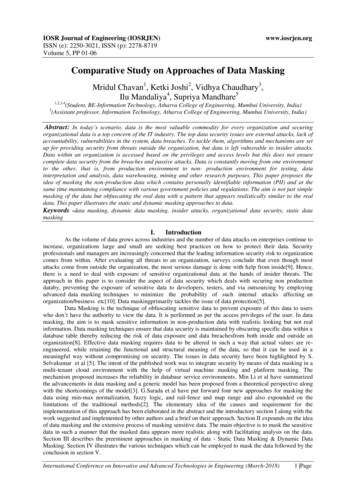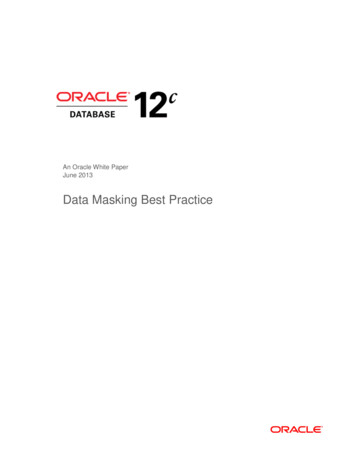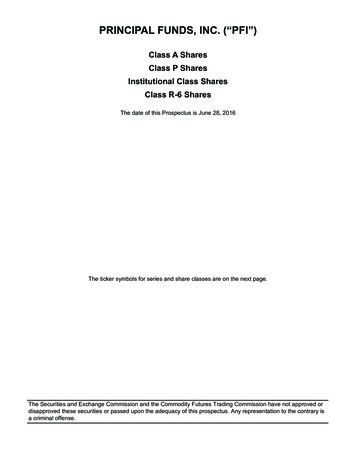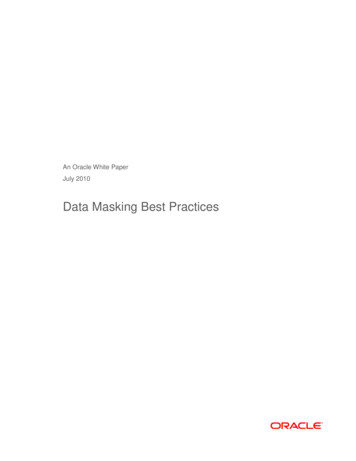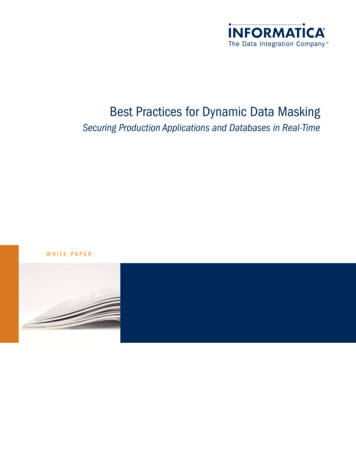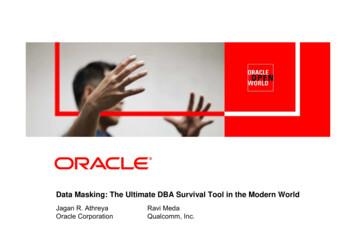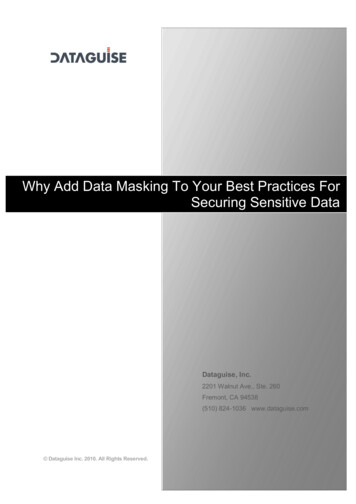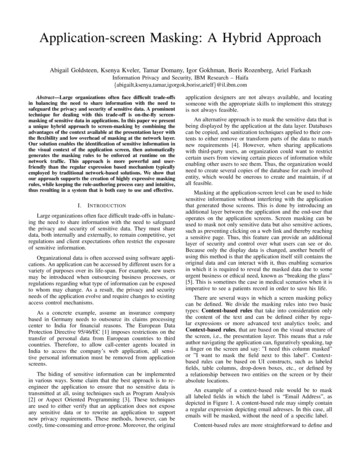
Transcription
Application-screen Masking: A Hybrid ApproachAbigail Goldsteen, Ksenya Kveler, Tamar Domany, Igor Gokhman, Boris Rozenberg, Ariel FarkashInformation Privacy and Security, IBM Research – @il.ibm.comAbstract—Large organizations often face difficult trade-offsin balancing the need to share information with the need tosafeguard the privacy and security of sensitive data. A prominenttechnique for dealing with this trade-off is on-the-fly screenmasking of sensitive data in applications. In this paper we presenta unique hybrid approach to screen-masking by combining theadvantages of the context available at the presentation layer withthe flexibility and low overhead of masking at the network layer.Our solution enables the identification of sensitive information inthe visual context of the application screen, then automaticallygenerates the masking rules to be enforced at runtime on thenetwork traffic. This approach is more powerful and userfriendly than the regular expression based mechanism typicallyemployed by traditional network-based solutions. We show thatour approach supports the creation of highly expressive maskingrules, while keeping the rule-authoring process easy and intuitive,thus resulting in a system that is both easy to use and effective.I.I NTRODUCTIONLarge organizations often face difficult trade-offs in balancing the need to share information with the need to safeguardthe privacy and security of sensitive data. They must sharedata, both internally and externally, to remain competitive, yetregulations and client expectations often restrict the exposureof sensitive information.Organizational data is often accessed using software applications. An application can be accessed by different users for avariety of purposes over its life-span. For example, new usersmay be introduced when outsourcing business processes, orregulations regarding what type of information can be exposedto whom may change. As a result, the privacy and securityneeds of the application evolve and require changes to existingaccess control mechanisms.As a concrete example, assume an insurance companybased in Germany needs to outsource its claims processingcenter to India for financial reasons. The European DataProtection Directive 95/46/EC [1] imposes restrictions on thetransfer of personal data from European countries to thirdcountries. Therefore, to allow call-center agents located inIndia to access the company’s web application, all sensitive personal information must be removed from applicationscreens.The hiding of sensitive information can be implementedin various ways. Some claim that the best approach is to reengineer the application to ensure that no sensitive data istransmitted at all, using techniques such as Program Analysis[2] or Aspect Oriented Programming [3]. These techniquesare used to either verify that an application does not exposeany sensitive data or to rewrite an application to supportnew privacy requirements. These methods, however, can becostly, time-consuming and error-prone. Moreover, the originalapplication designers are not always available, and locatingsomeone with the appropriate skills to implement this strategyis not always feasible.An alternative approach is to mask the sensitive data that isbeing displayed by the application at the data layer. Databasescan be copied, and sanitization techniques applied to their contents to either remove or transform parts of the data to matchnew requirements [4]. However, when sharing applicationswith third-party users, an organization could want to restrictcertain users from viewing certain pieces of information whileenabling other users to see them. Thus, the organization wouldneed to create several copies of the database for each involvedentity, which would be onerous to create and maintain, if atall feasible.Masking at the application-screen level can be used to hidesensitive information without interfering with the applicationthat generated those screens. This is done by introducing anadditional layer between the application and the end-user thatoperates on the application screens. Screen masking can beused to mask not only sensitive data but also sensitive actions,such as preventing clicking on a web link and thereby reachinga sensitive page. Thus, this feature can provide an additionallayer of security and control over what users can see or do.Because only the display data is changed, another benefit ofusing this method is that the application itself still contains theoriginal data and can interact with it, thus enabling scenariosin which it is required to reveal the masked data due to someurgent business or ethical need, known as “breaking the glass”[5]. This is sometines the case in medical scenarios when it isimperative to see a patients record in order to save his life.There are several ways in which a screen masking policycan be defined. We divide the masking rules into two basictypes: Content-based rules that take into consideration onlythe content of the text and can be defined either by regular expressions or more advanced text analytics tools; andContext-based rules, that are based on the visual structure ofthe screen, i.e., the presentation layer. This means that a ruleauthor navigating the application can, figuratively speaking, tapa finger on the screen and say: ”I need this column masked”or ”I want to mask the field next to this label”. Contextbased rules can be based on UI constructs, such as labeledfields, table columns, drop-down boxes, etc., or defined bya relationship between two entities on the screen or by theirabsolute locations.An example of a context-based rule would be to maskall labeled fields in which the label is “Email Address”, asdepicted in Figure 1. A content-based rule may simply containa regular expression depicting email adresses. In this case, allemails will be masked, without the need of a specific label.Content-based rules are more straightforward to define and
Fig. 1.Context-based labeled field ruleenforce. For context-based rules, the task is more complicated.The gap between the concepts with which the administratordefines the rules, i.e., what is seen on the screen, and the codethat executes at runtime, is much wider. Context-based rulesmust somehow match between entities at the presentation layer(e.g., objects on the screen) and instructions that are executedat runtime (such as an exact coordinate or XPath [6]). Forexample, a rule author who wants to mask a table column withthe header “Phone”, as seen in Figure 3, needs to translate thisinto a formal instruction set that will implement the runtimemasking.Context-based rules give more flexibility than contentbased rules. An example would be masking only home phonenumbers and not work phone numbers. The tradeoff in creatingthis kind of rule is the need to formulate several rules to coverall instances in the application of home phone numbers (forexample, if they appear both in a form and in a table), whereasa content-based rule can cover all phone numbers in one rule.Several methods exist for implementing masking at theapplication-screen level. One method uses network-traffic inspection, or “protocol-sniffing” [7], to intercept data as itflows through the network toward the client machines and thenanalyzes and alters it. Current protocol-sniffing solutions areefficient, but they offer only simple content-based maskingrules. A different approach is to focus on the presentationlayer, using Optical Character Recognition (OCR) [8] (formore details see Section II). In this method, the screen iscaptured as an image, then analyzed and modified beforebeing displayed on the end-user’s screen. While this methodprovides powerful capabilities for context-based rule definition,it suffers from difficulties in handling complex screens andsevere performance issues.In this paper, we present a novel method for performingcontext-based screen-masking, that can conceal sensitive datafrom specific user roles, without requiring any changes to theexisting application or data stores, and without impacting theapplication’s functionality or the end-user’s experience. Weaddress applications that are delivered from a server to anyclient software, with particular focus on web applications.We tackle cases in which it is necessary to conceal sensitiveinformation on screens in a way that is transparent to theend-users operating them, while striving to minimize theperformance impact. We use the protocol-sniffing approach toperform the masking, which does not require any changes tothe existing application or data stores, nor does it require anyinstallation on the end-user’s machine.Our main contribution is a hybrid approach that combinesenforcement at the network level with powerful context capabilities resulting from defining the masking rules at the presentation level. We provide an intuitive, visual rule-authoringprocess, that does not require great technical expertise, makingit easy to create and modify masking rules. Our network-basedimplementation has negligible impact on runtime performance.This results in a system that is both easy to use and effective.Combining visual context capabilites with masking at thenetwork level is a novel approach which presented severaltechnical difficulties that are discussed in later sections.This paper is organized as follows: Section II describesrelated work, Section III describes details of our approachand Section IV discusses the advantages and drawbacks ofour solution compared to the alternatives. Section V includessome performance results. We summarize our implementationand suggest directions for future work in Section VI.II.R ELATED WORKThe subject of privacy, security, and integrity of webapplications has received much research attention. A largevolume of work deals with identifying vulnerabilities [9][10]and faulty input sanitization procedures [11] using various codeanalysis techniques. Side-channel weakness is analyzed in [12]to demonstrate that sensitive information is being leaked fromweb traffic despite encryption.Techniques for proactive security and privacy integrationinto applications have also been suggested. The Servlet Information Flow (SIF) framework [13] can be used for buildinghigh-assurance web applications and using language-basedinformation-flow control to enforce the appropriate releaseof confidential information to clients. In cases in which itis not possible to proactively integrate security and privacyinto the design of the system because of economic, practical,or historical reasons, retroactive program analysis techniquesand tools can assist in retrofitting appropriate mechanisms intolegacy code [14] as the need arises.A number of research efforts and commercial productsdeal with sensitive-data leakage prevention by modifying datastores. These techniques and tools usually hide sensitive datain databases by systematically removing or transforming theircontents, in a way that keeps data realistic yet de-identified[15]. Sophisticated data masking algorithms are employed [16]to ensure that dataset-level properties and statistics remainapproximately the same, allowing for research and data mining. Commercial products such as IBM Optim [17], OracleData Masking [18], Camouflage [19], and Voltage SecureDataMasking [20] offer data-masking capabilities while preservingdata usefulness and referential integrity.Unfortunately, methods such as proactively designing applications with privacy in mind, re-engineering legacy applications, or masking data stores, are costly and not alwaysfeasible. Existing applications, especially legacy programs, arerarely re-written, and maintaining separate copies of the application database for different user roles can be very difficult.Changes to the underlying database may also impact the application’s functionality. In such cases, on-the-fly applicationscreen masking is a potential solution.
Verdasys Digital Guardian Application Logging and Masking Module [21] provides screen-masking support on Windowsplatforms. However the Verdasys technology depends on asoftware component which must be be installed on everyclient machine where screen-masking capabilities are required.In addition, client-side solutions are considered less safe asthe sensitive information arrives at the client machine and ismasked there.Another screen-masking method uses OCR [8] as the coretechnology to capture, analyze, and mask application screens.Screens are intercepted at the point where the screen imageis rendered, and then rerouted to discover and mask thesensitive texts before displaying them to the end user. Thismethod is independent of the protocol and platform, but it hasmany challenges in recognizing entities on the screen due tooverlapping, scrolling, and other complex screen structures.This technique also requires that operations like copy&pasteor print-screen be prevented to avoid revealing the sensitiveinformation. However, the main drawback of this method isthe performance impact.Network-traffic inspection is a widely used method forapplication-screen masking and other purposes. The IntellinxEnterprise Fraud Detection and Prevention solution [22] employs network-traffic sniffing to record end-user interactionsfor auditing and fraud detection. This solution allows themasking of recorded screens to prevent an auditor fromseeing sensitive information. However, to the best of ourknowledge, no on-the-fly masking is performed while endusers are working with application screens. IBM InfosphereGuardium [23] employs network-sniffing techniques for realtime database security, monitoring, and auditing. Check PointTMDLP Software Blade [24] inspects data transmitted overnetworks in order to detect and avoid sensitive informationloss. However this application does not seem to allow maskingof the data in-motion. Sensitive data can be identified by theirsimilarity to commonly-used templates, which is a primitiveform of context-based rules, but with a much smaller scopeand flexibility than our approach. They also use a scriptinglanguage for tailoring custom cases, but it suffers from severeusability issues.Privacy Infrastructure Appliance (PIA) [25], inspects communications to anonymize sensitive data sent from servicetakers to service providers, without changing the application.However, this appliance deals with the use of a third-partyapplication supplied by a service provider, where the sensitivedata can be seen and manipulated by the application users,but cannot be stored in the application database. The systemalso requires sensitive data tagging, so that it can be identifiedand replaced with masking tokens at runtime. Riverbed RTMStingray Traffic Manager [26] provides application-screenmasking by network-traffic inspection. It employs contentbased string-matching techniques, such as regular expressions,to define the targets to mask. The approach we present in thispaper enables the definition of comprehensive context-basedmasking rules, which take into consideration UI constructswithout any explicit tagging.III.O UR APPROACHIn this section, we describe our solution for applicationscreen masking with context-based rules. Our approach isFig. 2.High level architecturebased on intercepting network messages sent between a serverand a client and altering them according to rules.A. Solution designThe core component of the system is a “sniffer”, whichintercepts all requests sent from the client to the server andall response messages sent from the server to the client. Foreach response that carries information for display, a rule setis traversed to check if any masking rule should be applied.If such a rule is found, the response is altered according tothe rule before it is sent to the client. Note that the sensitiveinformation is completely removed from the message and doesnot reach the client machine. The client that receives themessages renders the screen to the display.The client requests are also intercepted to check if theyinclude information that was previously masked. If so, therequest is reconstructed with the correct data, meaning themasked data in the request is replaced with the original data,which was saved in the “sniffer”, before being sent to theserver. This way the application gets the correct data in therequest, and we do not “break” the application.In the first phase of the work we focus on web applications,thus restricting ourselves to dealing with the HTTP and HTTPSprotocols out of the many available application networkingprotocols. Figure 2 illustrates a sample architecture for webapplications. The network is configured to send all communications between the application server and the client browsersthrough a proxy server. The proxy then passes the messagesto an ICAP [27] server. An ICAP service parses the messageheaders and passes the relevant information to the enforcercomponent. The enforcer uses the message headers to searchfor relevant rules in the rule set. If it finds one or more rulesthat should be applied to the message, it parses the payloadand enforces those rules.Since all sensitive information is removed from the message, it does not reach the browser, and thus cannot be revealedby the end user, even when performing ’view source’. In
addition, both the masking server and the proxy itself areplaced within the enterprise’s internal network or firewall,thus preventing any sensitive information from leaving thepremises.Our implementation uses several Open Source components.For the HTTP proxy capabilities, we use the Squid proxy[28], for the ICAP implementation, we chose c-icap [29] andadded an ICAP service that transfers the messages to the ruleenforcer.HTTP message payloads may come in many different formats (e.g., HyperText Markup Language (HTML), ExtensibleMarkup Language (XML), JavaScript, JavaScript Object Notation (JSON), plain text, etc.). After observing a representativesample of applications, we found that the most frequent dataformats are HTML and XML. In newer applications, JSONhas become prevalent. Consequently, we integrated parsers forHTML, XML and JSON, using the the Libxml2 [30] andJansson [31] implementations respectively.B. Rule language and enforcementPlacing our enforcement component on the network allowsus to access and alter almost any piece of information thatappears on the screen. When creating a masking rule, the ruleauthor may choose to apply certain filters that affect whichmessages the rule will be applied to. Such filters may includethe server or client IP addresses, a certain user or group ofusers, and a URL pattern. At runtime, the server and client IPsas well as the request URL are provided as part of the HTTPprotocol. To identify the current user, the system recognizesthe application login process and extracts the username fromthe corresponding message. That username is then bound to thecurrent session until a logout is performed. All this informationis taken into account when deciding whether to apply a rule.Once the system has decided that a rule should be appliedto a message, the information to mask must be identified withinthe message. Our masking system supports both content-basedand context-based masking rules. This enables the rule authorto select the more suitable type of rule according to hismasking needs. For example, if all email addresses in theapplication need to be masked, using a content-based rule isbest. On the other hand, if only a few email addresses should bemasked (and others should not), a context-based masking ruleis more suitable. Context-based masking is also appropriatefor masking texts that do not have a pre-defined format, suchas names. The focus of this paper is the context-based partof our rule language, since content-based rules are relativelystraightforward to create and enforce.A masking rule must also specify what type of masking toperform. There are numerous possibilites, ranging from simplyremoving the values, changing the visual representation (suchas modifying the background color in addition to removingthe text value), replacing the original value with a differentfictitious one, and many more.To achieve this level of flexibility, in addition to the majorrequirement of minimizing the impact on performance, wedescribe our rules in JavaScript and use the SpiderMonkey interpreter [32] to execute them. Each rule contains a JavaScriptscript describing the changes to be performed on a givenFig. 3.Column masked by enforcing the script from Listing 1message at runtime. This expressive scripting language enablesspecifying any type of context-based rule, including any screenconstruct and any type of relationship between elements on thescreen, regardless of the data format. Listing 1 shows a scriptthat can change a message where the payload carrying the datais in HTML. The result of executing it can be seen in Figure3.The fact that our solution resides on the network, caninspect all passing messages and employ scripts on them givesus fine-grain control over the masked elements and enables usto mask exactly what is needed. The limitation of such anapproach is that we cannot mask information that does notflow over the network, i.e., that is generated on the client-side.An example of such information is an average that is calculatedin the browser using Javascript.var elements 1]/tr/td[7]/text()");for (n in elements) {html.mask(elements[n]);}Listing 1.messageMasking script to cover a table column arriving in an HTMLC. Visual rule-authoringA usable masking system should allow the rule author toeasily create a new rule or modify an existing one. However,it is generally the case that the more powerful a language is,the more complicated it is to generate rules.Generating context-based masking rules can be significantly more complex than rules handled by traditionalprotocol-sniffing mechanisms, as they relate to how the information is displayed on the screen and not just to the contentof the texts. Part of the problem stems from the fact thatinformation flowing through the network is not easily mappedto a displayed element. A simple table appearing on the screencan arrive as several messages, possibly in different formats,each carrying a chunk of information, which is ultimatelytranslated to a single table on the client side. For example,a table in a web application may arrive in three separatemessages: one HTML message describing the column headers,fonts, and colors, the second message containing the actualdata in JSON format, and a third message containing a scriptthat generates totals and summaries for the table.
Defining these rules manually would result in a significantloss in usability, due to the expertise required for correlatingthe presentation layer with the underlying network traffic.For example, to define a rule for masking a table columnon a web application page, rule authors would first needto see how that page is presented by the browser. Theywould then check the page source or intercept network trafficmessages to determine whether the table content is in HTML,or is built on demand by Asynchronous JavaScript and XML(AJAX) requests. The authors may be required to understandthe association between Document Object Model (DOM) elements and the target column. They may also need to analyzethe network message payload to discover exactly where theinformation to mask is located. After the masking target isisolated, the author still needs to create a masking script,validate its syntactic correctness, and confirm that the maskingis performed correctly on the displayed page.The rule author thus requires expertise in several disparatetechnologies and tools, and is involved in a lengthy errorprone process. To overcome this difficulty, we propose a hybridapproach that enables creating rules in the “language” of thepresentation even though they are enforced in the “language”of the protocol, using a visual rule-authoring tool to aid in thiscomplicated task.Our rule-authoring tool is a visual editor that enables thecreation of powerful context-based rules in an intuitive anduser-friendly manner, while navigating the target applicationscreens and selecting areas to mask. A panel attached tothe application enables the selection of a context on thepresentation layer by pointing the mouse and indicating thatthis area (e.g., table column) is to be masked. The selection isthen transformed into a machine-readable masking rule to berun during enforcement.Figure 4 demonstrates our implementation of the visualrule-authoring tool for web applications. To avoid installationon authors’ machines, we implemented a web-based tool,allowing authors to define rules using a web browser. In ruleauthoring mode, authors can navigate the target application in anatural manner, emulating end-users’ normal operation. Whenan area to be masked is selected (such as the table columnselection in Figure 4), the tool performs a combined analysisof both presentation and network traffic data to automaticallycreate JavaScript-based rules for masking the selection. Byperforming contextual analysis of the page structure, the toolis able to provide visual hints to the administrator, suchas automatically expanding the selection to the whole tablecolumn when hovering over one of the table cells or whena certain cell is selected. After the selection is made and therules are generated, the tool can show an in-place preview ofthe resulting masking, providing immediate feedback for rulevalidation.Defining the masking rule in the visual context of thepresentation layer allows an intuitive and humanly-manageableway to author masking rules. Transforming these rules to amachine-readable format to be applied at the network protocollevel prevents common maladies of existing presentation-basedmethods, e.g., difficulty in handling complex screens andperformance issues. Extensive user studies with real administrators are planned to test the usability of our rule authoringFig. 4. Visual rule-authoring panel on top of a web application page withtable column is selectedmechanism.The main technical challenges in implementing the visualrule-authoring tool were: Automatically translating the visually described policies into machine-readable instructions Overcoming the security barriers so that the tool caninteract with and inspect the target applicationThese issues are addressed below.1. Automatic rule generationThe first task in automatic rule generation is determiningthe origin of each visual element that appears on the screen.This involves identifying the event that caused the display, andthe source of the data content that is displayedEach modification of an element on the screen can originateeither from an incoming HTTP message (network-originatedmodification) or from some other activity, such as JavaScriptcode (locally-originated modification). It is not always straightforward to deduce which event caused an element on thescreen to be created or modified. For example, JavaScript codeactivated on a timer event or as a result of user input couldoccur simultaneously with the arrival of an HTTP message.It is also complicated to identify the data source of eachscreen element, i.e., to determine which message supplied thedata, as well as detect the data location within the message.The source of the data may be any HTTP message receivedfrom the web server as a result of a GET/POST request fromthe browser, an AJAX request initiated by the web applicationitself, or even a value computed locally by the browser.The method we will describe shortly enables: Automatic differentiation between network-originatedand locally-originated modifications. Automatic identification of the data source (specificmessage) for each element presented on the screen. Automatic detection of the exact location of the presented data in the corresponding message.
Returning to the example in Figure 3, our method canautomatically identify that the data in the “Phone” columncomes from the specified HTTP message and create themasking script presented in Listing 1.To acheive this, we monitor web page modifications interms of DOM tree changes and capture only those changes onthe web page that were initiated by HTTP messages (networkoriginated changes), while filtering out all other changes(locally-originated changes). The modified DOM elements thatpass this filter are then mapped to the pieces of data withinthe HTTP messages that caused the change in these elements.The following algorithm produces a map between visualelements presented in the browser and the HTTP messagesand locations within the messages that contain the elements’data.1)2)3)4)5)6)Capture the original HTML message that built thepage and create a temporal DOM tree from its contents (not including script tags).For each element in the tree, save the URL of themessage it originated from and the location of theelement within the message (e.g., XPath).Capture all AJAX requests and responses during pageloading and modification. This is achieved by overriding the native XMLHTTPRequest JavaScript objectimplementation provided by the web browser, andadding sniffing functionality to the ”send” methodand the ”onreadystatechange” event handler.For each AJAX request, compare the DOM treesbefore and after the request is completed. Mark allDOM elements that were added or modified as probably originating from the AJAX request (although theymay also have been created or modified by JavaScriptcode or by the browser itself).For each element collected in the previous stage, extract its textual content and check whether the contentindeed appears in the incoming AJAX response. If itdoes, save the URL of the HTTP message containingthe data and the location of the data within themessage.Compare the resulting DOM after the page has beenloaded with the initial DOM. Define a
Sophisticated data masking algorithms are employed [16] to ensure that dataset-level properties and statistics remain approximately the same, allowing for research and data min-ing. Commercial products such as IBM Optim [17], Oracle Data Masking [18], Camouflage [19], and Voltage SecureData Masking [20] offer data-masking capabilities while .

